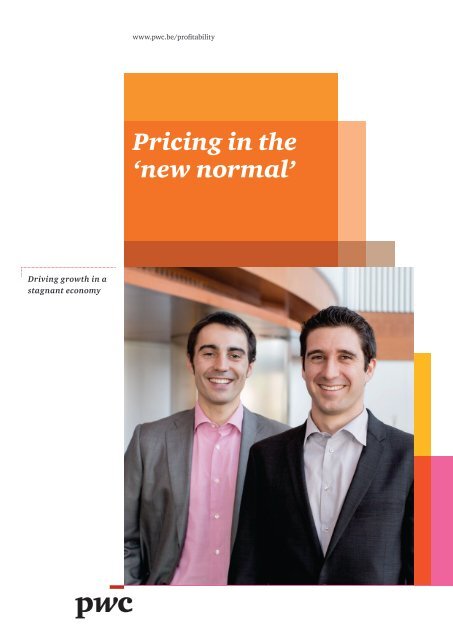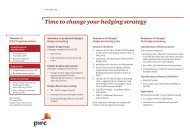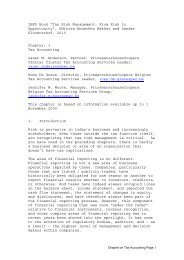Pricing in the 'new normal' - PwC
Pricing in the 'new normal' - PwC
Pricing in the 'new normal' - PwC
You also want an ePaper? Increase the reach of your titles
YUMPU automatically turns print PDFs into web optimized ePapers that Google loves.
www.pwc.be/profitability<br />
<strong>Pric<strong>in</strong>g</strong> <strong>in</strong> <strong>the</strong><br />
‘new normal’<br />
Driv<strong>in</strong>g growth <strong>in</strong> a<br />
stagnant economy
In summary<br />
• <strong>Pric<strong>in</strong>g</strong> is a key growth and profit<br />
lever <strong>in</strong> <strong>the</strong> current economic<br />
environment<br />
• Most bus<strong>in</strong>esses are yet to achieve<br />
pric<strong>in</strong>g excellence<br />
• Tak<strong>in</strong>g different perspectives on<br />
pric<strong>in</strong>g highlights significant<br />
opportunities<br />
• <strong>Pric<strong>in</strong>g</strong> excellence requires senior<br />
management commitment
<strong>Pric<strong>in</strong>g</strong> is a key growth and<br />
profit lever <strong>in</strong> <strong>the</strong> ‘new normal’<br />
The ‘new normal’ is<br />
characterised by low growth,<br />
high <strong>in</strong>flation and volatility<br />
The ‘new normal’ is forecast as a<br />
prolonged period of disappo<strong>in</strong>t<strong>in</strong>g GDP<br />
and consumer spend<strong>in</strong>g growth <strong>in</strong><br />
western economies, last<strong>in</strong>g <strong>in</strong>to<br />
mid-2010s. There will be periodic<br />
bursts of <strong>in</strong>flation, driven by energy<br />
and commodity price movements,<br />
add<strong>in</strong>g to growth volatility. Prices for<br />
energy and o<strong>the</strong>r natural resources are<br />
expected to be high, and f<strong>in</strong>ancial<br />
market volatility is forecast to<br />
cont<strong>in</strong>ue.<br />
Figure 1<br />
The power of pric<strong>in</strong>g<br />
Volume growth is hard to<br />
achieve and cost reduction<br />
opportunities have been largely<br />
exhausted<br />
Before <strong>the</strong> f<strong>in</strong>ancial crisis, helpful<br />
tailw<strong>in</strong>ds meant economic growth<br />
could be taken for granted which is no<br />
longer <strong>the</strong> case. Driv<strong>in</strong>g growth<br />
through M&A is an option, but gett<strong>in</strong>g<br />
deals done is not straightforward given<br />
economic uncerta<strong>in</strong>ties.<br />
In developed economies, most<br />
companies have largely exhausted cost<br />
reduction opportunities.<br />
Price pressure and volatility<br />
are <strong>in</strong>creas<strong>in</strong>g<br />
Price pressure is <strong>in</strong>creas<strong>in</strong>g; consumer<br />
confidence and spend<strong>in</strong>g cont<strong>in</strong>ues to<br />
be depressed and price transparency is<br />
<strong>in</strong>creas<strong>in</strong>g, whilst companies are<br />
focuss<strong>in</strong>g more on optimis<strong>in</strong>g<br />
procurement.<br />
Increased volatility of both demand<br />
and costs is mak<strong>in</strong>g pric<strong>in</strong>g, and<br />
forecast<strong>in</strong>g and manag<strong>in</strong>g profit,<br />
<strong>in</strong>creas<strong>in</strong>gly challeng<strong>in</strong>g.<br />
<strong>Pric<strong>in</strong>g</strong> is a key profit lever<br />
In this ‘new normal’ economic<br />
environment of low volume growth,<br />
ris<strong>in</strong>g price pressure and greater<br />
volatility, achiev<strong>in</strong>g pric<strong>in</strong>g excellence<br />
is a key source of competitive<br />
advantage.<br />
Unlike o<strong>the</strong>r levers, such as grow<strong>in</strong>g<br />
volume or reduc<strong>in</strong>g operat<strong>in</strong>g costs,<br />
pric<strong>in</strong>g changes fall directly to <strong>the</strong><br />
bottom l<strong>in</strong>e, with a 1% price <strong>in</strong>crease<br />
on average deliver<strong>in</strong>g an 8% impact on<br />
profit. Even small improvements can<br />
have a material f<strong>in</strong>ancial impact and<br />
are worth pursu<strong>in</strong>g.<br />
Source: <strong>PwC</strong> analysis<br />
<strong>Pric<strong>in</strong>g</strong> <strong>in</strong> <strong>the</strong> ‘new normal’<br />
1
Most bus<strong>in</strong>ess have not<br />
fully tapped <strong>the</strong>ir pric<strong>in</strong>g potential<br />
Most<br />
bus<strong>in</strong>esses<br />
fail to<br />
optimise<br />
pric<strong>in</strong>g<br />
Whilst pric<strong>in</strong>g is a key profit lever, most bus<strong>in</strong>esses fail to fully realise <strong>the</strong>ir pric<strong>in</strong>g potential.<br />
In our experience, this is due to a multitude of factors:<br />
• Quantify<strong>in</strong>g <strong>the</strong> benefits from pric<strong>in</strong>g changes is harder than for operational changes and requires<br />
considerable judgement<br />
• Identify<strong>in</strong>g pric<strong>in</strong>g opportunities is an analytical task and often requires external market/customer<br />
<strong>in</strong>formation which can be overwhelm<strong>in</strong>g for many bus<strong>in</strong>ess to collect and <strong>the</strong>n analyse<br />
• <strong>Pric<strong>in</strong>g</strong> has a market impact and can change customer and competitor behaviour and is <strong>the</strong>refore<br />
seen as high risk<br />
• Realis<strong>in</strong>g benefits from pric<strong>in</strong>g <strong>in</strong>sights can be multi-discipl<strong>in</strong>ary <strong>in</strong>volv<strong>in</strong>g changes <strong>in</strong> sales and<br />
market<strong>in</strong>g, product development and even strategy<br />
• Companies see <strong>the</strong>ir markets as competitive with little or no room to <strong>in</strong>crease prices<br />
• <strong>Pric<strong>in</strong>g</strong> is considered to be tactical and not strategic and receives little focus<br />
• Often <strong>the</strong>re is no clear accountability for pric<strong>in</strong>g and it <strong>the</strong>refore does not receive <strong>the</strong> same focus as<br />
say operations, f<strong>in</strong>ance or IT which are competency areas or cost centres <strong>in</strong> most organisations<br />
Sub-optimal<br />
pric<strong>in</strong>g has<br />
a negative<br />
impact on<br />
performance<br />
Due to sub-optimal pric<strong>in</strong>g, many companies <strong>in</strong>advertently:<br />
• Set prices based on cost plus or competitor prices ra<strong>the</strong>r than <strong>the</strong> value customers perceive<br />
• Price to maximise sales and/or volume ra<strong>the</strong>r than profit<br />
• Provide rebates or market<strong>in</strong>g <strong>in</strong>centives that are not commensurate with <strong>the</strong> volume of bus<strong>in</strong>ess<br />
received<br />
• Do not capture opportunities to <strong>in</strong>crease prices due to market changes<br />
• Over discount or discount at <strong>the</strong> wrong time<br />
• Undercharge given <strong>the</strong> benefits customers’ receive relative to alternatives<br />
• Invest <strong>in</strong> products/services that are thought to be marg<strong>in</strong> additive but which are marg<strong>in</strong> dilutive<br />
<strong>Pric<strong>in</strong>g</strong> excellence requires<br />
mak<strong>in</strong>g a trade-off between<br />
price, volume and profit. It is<br />
achieved by hav<strong>in</strong>g a deep<br />
understand<strong>in</strong>g of customer<br />
value drivers, and<br />
facilitat<strong>in</strong>g <strong>the</strong> organisation<br />
to deliver what customers<br />
want, at a price that <strong>the</strong>y are<br />
will<strong>in</strong>gly pay.<br />
2 <strong>Pric<strong>in</strong>g</strong> <strong>in</strong> <strong>the</strong> ‘new normal’
<strong>Pric<strong>in</strong>g</strong> excellence requires<br />
tak<strong>in</strong>g different perspectives and<br />
senior management commitment<br />
Consider<strong>in</strong>g pric<strong>in</strong>g from<br />
different perspectives<br />
highlights significant<br />
opportunities<br />
Consider<strong>in</strong>g pric<strong>in</strong>g from different<br />
perspectives simplifies a complex<br />
subject and unearths opportunities.<br />
In our experience work<strong>in</strong>g with<br />
companies across a range of <strong>in</strong>dustries,<br />
<strong>the</strong>re are four perspectives that are<br />
particularly useful to consider:<br />
Industry<br />
lens<br />
Industry level trends such as changes <strong>in</strong><br />
<strong>the</strong> supply and demand balance <strong>in</strong> a<br />
market or cost changes, impact different<br />
<strong>in</strong>dustries to different degrees. However<br />
<strong>in</strong> all cases, a forward look<strong>in</strong>g<br />
understand<strong>in</strong>g of how an <strong>in</strong>dustry is<br />
chang<strong>in</strong>g is an important consideration<br />
<strong>in</strong> pric<strong>in</strong>g, particularly <strong>in</strong> <strong>the</strong> current<br />
volatile markets.<br />
Customer<br />
lens<br />
Individual customers attach differ<strong>in</strong>g<br />
levels of value to different product/<br />
service benefits. Deeply understand<strong>in</strong>g<br />
<strong>the</strong>se value associations, how demand<br />
changes with price changes, and how to<br />
position offer<strong>in</strong>gs versus competitors, is<br />
a core competency <strong>in</strong> achiev<strong>in</strong>g pric<strong>in</strong>g<br />
excellence.<br />
Realis<strong>in</strong>g <strong>the</strong> benefits from changes <strong>in</strong><br />
pric<strong>in</strong>g requires alignment across<br />
functions, with clear responsibilities for<br />
price sett<strong>in</strong>g, <strong>the</strong> right organisational<br />
structure and <strong>in</strong>centives, as well as <strong>the</strong><br />
tools, technology and processes to<br />
support pric<strong>in</strong>g objectives and monitor<br />
performance.<br />
Understand<strong>in</strong>g prices achieved on a<br />
transaction by transaction basis, across<br />
customers, products and channels is<br />
critical. Know<strong>in</strong>g <strong>the</strong> true cost to serve,<br />
whe<strong>the</strong>r discounts are commensurate<br />
with purchase volumes and if rebates are<br />
justified, requires granular analytical<br />
<strong>in</strong>sight and f<strong>in</strong>ancial rigour.<br />
Operations<br />
lens<br />
Transaction<br />
lens<br />
Susta<strong>in</strong>able pric<strong>in</strong>g excellence<br />
requires senior management<br />
commitment<br />
Us<strong>in</strong>g pric<strong>in</strong>g to improve profitability<br />
does not always come down to simply<br />
<strong>in</strong>creas<strong>in</strong>g prices. Often changes <strong>in</strong><br />
product/service features, market<strong>in</strong>g<br />
strategy, channel focus or <strong>the</strong> pric<strong>in</strong>g<br />
basis, for example airl<strong>in</strong>es decid<strong>in</strong>g to<br />
price for luggage separately, are <strong>the</strong><br />
key levers to improv<strong>in</strong>g performance.<br />
Consequently, effect<strong>in</strong>g <strong>the</strong> required<br />
changes and achiev<strong>in</strong>g susta<strong>in</strong>able<br />
pric<strong>in</strong>g excellence requires senior<br />
management attention and<br />
commitment.<br />
Has your bus<strong>in</strong>ess fully tapped its<br />
pric<strong>in</strong>g potential? Can you answer ‘yes’<br />
to <strong>the</strong> questions overleaf?<br />
<strong>Pric<strong>in</strong>g</strong> <strong>in</strong> <strong>the</strong> ‘new normal’<br />
3
Have you fully tapped<br />
your pric<strong>in</strong>g potential?<br />
<strong>Pric<strong>in</strong>g</strong> checklist<br />
Yes Somewhat No<br />
Customer<br />
1. We have a clear approach to segment<strong>in</strong>g our customers based on a deep<br />
understand<strong>in</strong>g of <strong>the</strong>ir needs, and frequently update <strong>the</strong> segmentation<br />
2. We really understand what product/service benefits each customer segment is<br />
prepared to pay for, and how much <strong>the</strong>y are will<strong>in</strong>g to pay<br />
3. We frequently use <strong>in</strong>sights from customer segmentation analysis to review our<br />
pric<strong>in</strong>g decisions<br />
4. We set prices based on <strong>the</strong> value our products/services provide to customers and<br />
not on a cost-plus or competitor benchmark<strong>in</strong>g basis<br />
Industry<br />
5. We track key <strong>in</strong>dustry factors <strong>in</strong>fluenc<strong>in</strong>g our pric<strong>in</strong>g decisions (e.g. supply/demand<br />
trends, cost trends, regulatory changes, etc.)<br />
6. We track competitor prices and have a fact-based approach to understand pric<strong>in</strong>g<br />
trends <strong>in</strong> <strong>the</strong> near, medium and long term<br />
7. We always consider pric<strong>in</strong>g implications of our key bus<strong>in</strong>ess decisions (e.g.<br />
<strong>in</strong>vestment <strong>in</strong> new capacity, M&A)<br />
Transactions<br />
8. We monitor prices we charge at a transaction by transaction/order by order level,<br />
on a weekly/monthly basis<br />
9. We are confident that we achieve <strong>the</strong> maximum possible price on every transaction<br />
10. We have a clear understand<strong>in</strong>g of <strong>the</strong> true cost to serve for each transaction<br />
Operations<br />
11. Senior management has accountability for and is <strong>in</strong>volved <strong>in</strong> pric<strong>in</strong>g decisions<br />
12. Our sales & market<strong>in</strong>g team’s <strong>in</strong>centives are aligned to our pric<strong>in</strong>g objectives<br />
13. We have a clearly def<strong>in</strong>ed and limited discount<strong>in</strong>g authority, and <strong>the</strong> rules are<br />
rigorously enforced<br />
14. We track <strong>the</strong> appropriate key performance <strong>in</strong>dicators on a timely basis to <strong>in</strong>form<br />
pric<strong>in</strong>g decisions at different levels of our organisation<br />
4<br />
<strong>Pric<strong>in</strong>g</strong> <strong>in</strong> <strong>the</strong> ‘new normal’
Case study<br />
Higher profits and high-quality service<br />
The context<br />
Our client faced a slowdown <strong>in</strong> sales<br />
volume growth, due to <strong>in</strong>creased<br />
competition and <strong>the</strong> economic<br />
downturn. Dur<strong>in</strong>g <strong>the</strong> last years <strong>the</strong>ir<br />
<strong>in</strong>ternal complexity <strong>in</strong>creased and<br />
prices of raw materials rose. On top of<br />
that, <strong>the</strong> organisation found it had no<br />
longer sufficient <strong>in</strong>sight <strong>in</strong>to what <strong>the</strong>ir<br />
customers were really look<strong>in</strong>g for...<br />
and will<strong>in</strong>g to pay, this all lead<strong>in</strong>g to<br />
lower profits. To cope with those<br />
challenges, <strong>the</strong> client started a<br />
programme to enhance profit while<br />
achiev<strong>in</strong>g higher service levels.<br />
<strong>PwC</strong> approach<br />
Toge<strong>the</strong>r we def<strong>in</strong>ed a strategic<br />
framework for future pric<strong>in</strong>g direction,<br />
conta<strong>in</strong><strong>in</strong>g 8 build<strong>in</strong>g blocks to br<strong>in</strong>g<br />
<strong>the</strong>ir pric<strong>in</strong>g organisation to <strong>the</strong> next<br />
level. Differentiated pric<strong>in</strong>g segments,<br />
a cross-functional pric<strong>in</strong>g board,<br />
fact-based price benchmarks and an<br />
execution tool for sales are only 4 of<br />
<strong>the</strong>m. With <strong>the</strong> client, we def<strong>in</strong>ed an<br />
action plan to do <strong>the</strong> detailed design<br />
and actual implementation of each of<br />
those 8 build<strong>in</strong>g blocks. This <strong>in</strong>volved<br />
price analytics to deduct <strong>the</strong> right<br />
pric<strong>in</strong>g rules, design<strong>in</strong>g <strong>the</strong> new<br />
price-sett<strong>in</strong>g mechanics and <strong>the</strong> right<br />
organisational structure, <strong>in</strong>centives,<br />
processes and tools to support <strong>the</strong><br />
pric<strong>in</strong>g objectives and monitor<br />
performance.<br />
We assisted <strong>the</strong> client as from <strong>the</strong><br />
def<strong>in</strong>ition of <strong>the</strong> pric<strong>in</strong>g strategy till<br />
<strong>the</strong> full implementation of <strong>the</strong> new<br />
processes, organisation and systems.<br />
Outcome<br />
A complete new pric<strong>in</strong>g organisation<br />
allow<strong>in</strong>g sales to quote faster and with<br />
more confidence. The new pricesett<strong>in</strong>g<br />
mechanics are embedded <strong>in</strong>to<br />
<strong>the</strong> systems, accompanied with clear<br />
price benchmarks and escalation rules.<br />
A higher focus on value, differentiated<br />
per customer segment, while cover<strong>in</strong>g<br />
<strong>the</strong> volatility <strong>in</strong> <strong>the</strong>ir raw materials.<br />
<strong>Pric<strong>in</strong>g</strong> <strong>in</strong> <strong>the</strong> ‘new normal’<br />
5
Contacts<br />
Pieter Bauwens<br />
Director, Belgium<br />
Tel: +32 (0) 9 268 8057<br />
pieter.bauwens@pwc.be<br />
Mark Haller<br />
Partner, US<br />
Tel: +1 312 298 2550<br />
mark.haller@us.pwc.com<br />
David Lancefield<br />
Partner, UK<br />
Tel: +44 (0) 20 721 32263<br />
david.lancefield@uk.pwc.com<br />
© 2012 <strong>PwC</strong> Belgium. All rights reserved.<br />
<strong>PwC</strong> helps organisations and <strong>in</strong>dividuals create <strong>the</strong> value <strong>the</strong>y’re look<strong>in</strong>g for. We’re a network of firms <strong>in</strong> 158 countries with more than<br />
180,000 people who are committed to deliver<strong>in</strong>g quality <strong>in</strong> assurance, tax and advisory services. Tell us what matters to you and f<strong>in</strong>d<br />
out more by visit<strong>in</strong>g us at www.pwc.com.<br />
In this document, <strong>PwC</strong> refers to <strong>the</strong> <strong>PwC</strong> network and/or one or more of its member firms, each of which is a separate legal entity.<br />
Please see www.pwc.com/structure for fur<strong>the</strong>r details.










